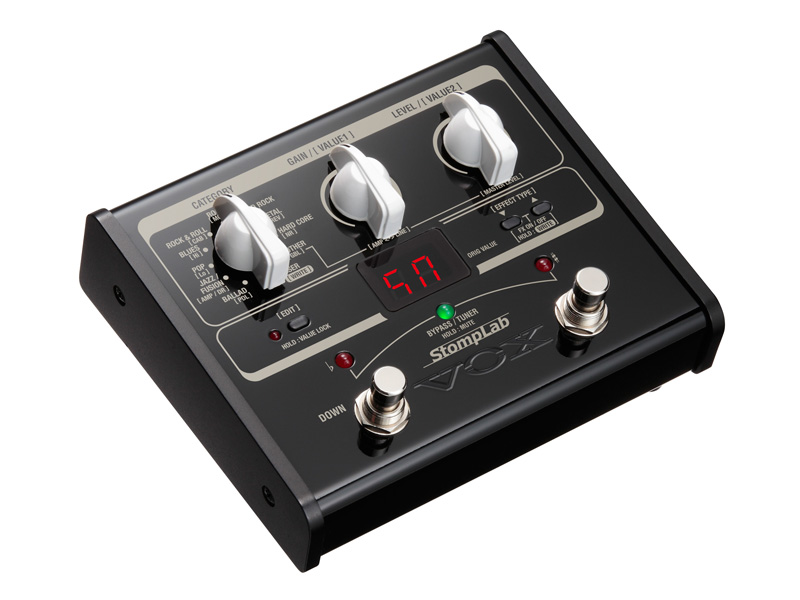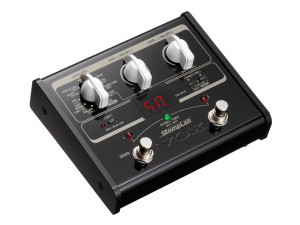
Gear Review: Low Priced Amp Modeling: the Vox Stomplab IG
The Vox Stomplab IG is a full-blown multiFX device that includes amp modeling, dynamics processing, a range of FX, delay, and reverb, all in a two-button stompbox design that runs on 4 AA batteries and sells new for under $70. I’ve had good experiences with Vox modeled amps, and I decided to give this box a try, especially because I’m not yet entirely satisfied with any of the battery-powered devices that I use for jam sessions and other situations where setup time is at a premium and AC isn’t always conveniently located, such as the Tech21 Blonde pedal. (I might be satisfied with the Blonde if it had delay and reverb, not to mention a rotary speaker and pitch shifter FX.)
First Impressions: Solid, not Perfect
The IG arrived from Sweetwater Sound last week. The form factor is very nice: smaller than a Digitech RP155, and very lightweight. The overall design could be improved. Yes, it runs on batteries, but to load the batteries you have to remove the rubber feet from the bottom of the device with a screwdriver. Whatever happened to removable battery cover panels? The device’s layout and user interface is fiddly and a bit complicated; most of the controls serve two functions at least, and every function is coded as a 2-digit mnemonic on the display, which means that you either memorize what all those (literally) hundreds of 2-digit codes mean (e.g. a 4×10 speaker cab model is coded as “t3”–that’s easy and intuitive, right?), or keep the manual close by while programming. The same issue applies to the Digitech RP155 (not to the RP250 and up), which only has a two-digit display, but the RP can be programmed using Digitech’s very good Xedit program, which gives you plenty of additional information about every parameter. Alas, the Stomplab has no USB port, so you can’t connect it to a computer for editing, saving, and loading patches. In summary, programming this thing is more difficult than I’d prefer.
The programmable memory is also much less extensive than the RP155’s: 20 user slots instead of 50. However, keeping in mind that I bought the thing for use in jam sessions, where you usually only need a few good sounds at most, that may not be a problem.
In Use: Sounds Good Without Too Much Work
I spent a few hours working with the Stomplab IG over the last couple of days. The architecture of a patch is very similar to the Digitech RPs, with 7 FX in a fixed order. The Stomplab’s fiddly interface is not terrifically helpful to a programmer. Among other things, the setting for any given function only is visible while you’re editing it; if you move away to edit something else, when you come back the parameter you previously edited resets to whatever the current rotary dial position is. That’s a real bummer: you can’t be sure what settings you just created unless you write them down as you go along. I like machines that remember that stuff for me.
Still, in a few hours I’ve managed to produce eleven or twelve good blues-rock amped tones for it, one of which is an uncanny match for a tone that I put together on the Digitech RP500 for the lead harp on my looped arrangement of “Key to the Highway”– a big loud amped sound with a slapback delay. In other words, the Stomplab sounds good, and it’s plenty loud.
Here’s a clip of me playing a groove with all of the sounds I’ve created for the Stomplab, one by one.
Overall: A Great Price For A Device That Makes Some Great Sounds
The Stomplab IG has a lot going for it at its price point of $70: a metal case and two metal footswitches, four bands of EQ on every patch, good FX, including nice delays and spring reverb, a decent pitch shifter, a rotary speaker effect that sounds very good, and a broad selection of good-sounding amp and cabinet models, including plenty of crunchy stuff. I really like the echo models, which have a big fat sound that adds a lot of depth to the harp tone. The most difficult omission to accept is the absence of a USB port and computer backup and restore for single patches and the entire user memory. But the price is amazing considering what’s in the box.
I’m trying to figure out how I can package these sounds for sale, but the fact that an owner can’t just plug the thing into a computer and load my stuff in makes it difficult. Perhaps I can figure out a way to communicate both the sound configurations and the process for setting it up to a Stomplab owner. I hope so; I think this device, with its low price, good sound, and high portability, could help a lot of people figure out that they need an amp modeling device in their kit.
Tags In
Related Posts
7 Comments
Leave a Reply
You must be logged in to post a comment.
WHAT’S NEW
Categories
- Audio/Video
- Blog
- Blue Future
- Digitech RP Tricks and Tips
- Discography, CDs, Projects, Info, Notes
- Featured Video
- For the Beginner
- Gallery
- Hunter's Effects
- Hunter's Music
- Huntersounds for Fender Mustang
- Meet the Pros
- More Video
- MPH: Maw/Preston/Hunter
- My Three Big Contributions
- Player's Resources
- Pro Tips & Techniques
- Recommended Artists & Recordings
- Recommended Gear
- Recorded Performances
- Reviews, Interviews, Testimonials
- The Lucky One
- Uncategorized
- Upcoming Performances
- Zoom G3 Tips and Tricks


As always, very cool. I go for traditional sounds mostly, the first one you have for the Vox Stomplab sounds very usable.
You noted the absence of a USB interface, but you’ve pressed on nonetheless and will hopefully make the patches available on a similar commercial basis to your other patch sets, even if they have to be loaded manually. Sending a few dollars and getting your sounds makes a lot more sense than fiddling around for hours and ending up with something far worse.
That said, would it be worth you revisiting the Korg Pandora? You looked at the Korg Pandora Stomp, but gave up as I recall becuase their computer interface didn’t work. I had a similar issue with my Korg Pandora PX5D a few years back.
However, my Korg Pandora PX5D has a very major plus. It runs for 6 hours at least on 2 AA batteries, new battery installation takes less than a minute. The Korg Pandora Stomp uses the less appealing and more expensive 9V batteries.
Moreover, Korg have released the Pandora Mini, which runs on just a single AA battery, making it the ultimate portable effects device.
I’ve been able to program a variety of good clean sounds on my Pandora PX5D (which I’m guessing is essentially the same as the Mini and the Stomp). However the amped sound which I came up with basically sucks. You could do much better.
So. If you’re inclined to persist with a device like the Vox Stomplab, despite the lack of a computer interface, could I persuade you to look at the Pandora Mini, due to its greatly superior battery setup. I’d end up sounding much better if you did.
@Tony: I dunno. I don’t like to set myself and my licensees up for bad experiences, especially because their bad experiences end up consuming lots of my time and effort, and leaving a bad taste in the customer’s mouth even when the outcome is good. The Korg software is basically crap–completely non-intuitive, and largely non-functional. Doesn’t matter how good the hardware sounds if you can’t set it up to do the job. At the moment I don’t have a Korg Pandora, because I sent it back to Sweetwater when I found out how horrible the software is. Maybe I’ll work my way up to trying it again, but not this week.
What are the 4 EQ frequencies? Does it have an AC adapter or the ability to attach one?
Thanks
I just got one of these guys in the mail today. I’ve only played around with it for about an hour, but your review seems pretty spot on. It sounds pretty darn good, but the programming is a little bit less than ideal, especially when you are used to the Digitech computer programs..
The one thing I did want to mention though, and I am not sure if you have figured this out since writing this review, but you do not actually need to use a screwdriver to remove the bottom panel. You can actually just turn the rubber feet with your fingers to unscrew them.. Its not as easy as a removable panel, but its much better than needing a screwdriver.. Anyways, thanks for the great review, i’m looking forward to playing with this thing more, and hopefully you figure out a way to share the sounds you created because I thought the ones in the clip sounded pretty awesome..
Cheers!
-A.J.
@AJ: I’ll see what I can do. I am finding that at volume it tends to feedback more than the RP, but of course I’ve spent a lot more time with the RP.
[…] choice mentioned in the article is the Vox Stomplab IIG; we’ve discussed its little brother the IG, which has the same sounds minus the expression pedal on the IIG, on this […]
I just got one of these guys in the mail today. I’ve only played around with it for about an hour, but your review seems pretty spot on. It sounds pretty darn good, but the programming is a little bit less than ideal, especially when you are used to the Digitech computer programs..
The one thing I did want to mention though, and I am not sure if you have figured this out since writing this review, but you do not actually need to use a screwdriver to remove the bottom panel. You can actually just turn the rubber feet with your fingers to unscrew them.. Its not as easy as a removable panel, but its much better than needing a screwdriver.. Anyways, thanks for the great review, i’m looking forward to playing with this thing more, and hopefully you figure out a way to share the sounds you created because I thought the ones in the clip sounded pretty awesome..
Cheers!
-A.J.